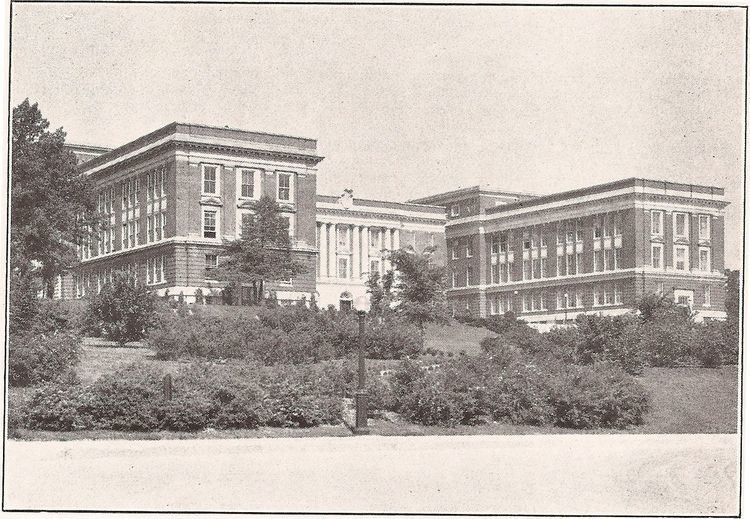 | ||
Building 40, Army Medical School is a Georgian revival structure in the Walter Reed Army Medical Center complex in northern Washington, D.C., USA. It was built between 1922 and 1932 to house the Army Medical School, which became the Army Medical Center in 1923 when it — under the name “Medical Department Professional Service School” (MDPSS) — combined with the Walter Reed General Hospital. The MDPSS ultimately became the Walter Reed Army Institute of Research, which occupied Building 40 from 1953 to 1999. It comprises four wings, known as the Craig (1924), Sternberg and Vedder (1932), and Siler (1962) Pavilions and is situated at 14th and Dahlia Streets.
Contents
Overview
The original block of Building 40 is designed in a more elaborate version of the Colonial/Georgian-Revival style established in the nearby Walter Reed General Hospital (Building 1). The large, brick, three-story building is embellished with elaborate classical limestone trim at its entrances. The raised basement is stone. The three main floors are brick; rusticated on the first floor and smooth on the second and third, with stone belt courses and a deep projecting dentilled stone cornice. A high parapet surrounds the flat roof. It is a complex brick and limestone structure, consisting of an original H-shaped block and a lster addition on the west. The original block appears to have been designed as a unit.
The east elevation was clearly intended to be the principal façade of the original building. The main entrance is located in the center of the crossbar of the H and the end elevations of both projecting wings are elaborately finished. Four pairs of giant order Tuscan engaged columns ornament the monumental pedimented pavilion that houses the main entrance and a large stone cartouche, bearing the caduceus symbol of the U.S. Army Medical Corps, is mounted in the center of the parapet. Today, air conditioners and pipes, probably used for ventilation, protrude from all major elevations. The entire building is now (2009) vacant and in bad condition, with many broken windows and evidence of water damage on the interior.
Pavilions
The long north and south pavilions (wings) of the original building are virtually identical. The south (Craig) pavilion was completed in 1924, but work on the parallel north (Vedder) pavilion and the Sternberg crossbar apparently continued until 1932. The addition, the Siler Pavilion, was reportedly built in 1962, but appears much older. The outward-facing front elevation of each wing consists of four bays, each containing groupings of three windows, on either side of a projecting five-bay central pavilion that contains the main entrance. Within each side bay, rectangular stone panels combine the windows on the second and third floor into vertical groupings. On the east ends of the wings, double entrance doors are set within molded stone surrounds and brick pilasters with stone pedestals and caps frame the windows on the second and third floors.
Addition
An addition covers the entire west elevation of the original block. Because the lot slopes slightly from east to west, this elevation is a full four stories high. The stripped Classical style of the addition was designed to harmonize with the original block. The limestone water table, belt course, and projecting cornice are simplified versions of the ones on the original block. Recessed metal panels tie the eight-pane metal-framed casement windows on the first, second, and third levels into the same kind of vertical grouping found on the original building. There are two simple double entrance doors at the basement level on the west elevation. There is a loading dock in the full-height basement level at the south end of the addition.
History
Building 40 was home to the four successors to the Army Medical School: the Medical Department Professional Service School (1923-1947), the Army Medical Department Research and Graduate School (1947-1950), the Army Medical Service Graduate School (1950-1953), and finally the Walter Reed Army Institute of Research (1953-1999). In 1999, WRAIR relocated to its present Forest Glen, Maryland site.
One of the earliest nuclear reactors in the United States was installed in the basement of the building's addition. The reactor was decommissioned in the late 1970s.
In 2009, Building 40 was proposed for historic landmark status along with a proposed "Walter Reed Army Medical Center Historic District"
